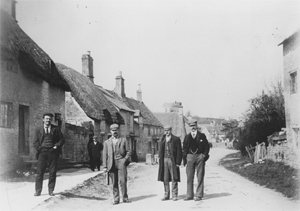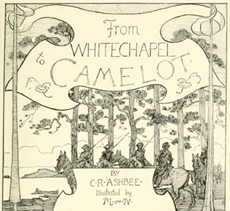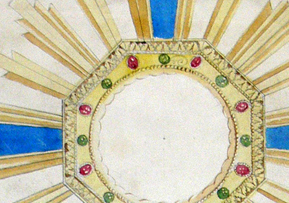Ashbee and After: Drawing in the Silversmiths’ Workshop
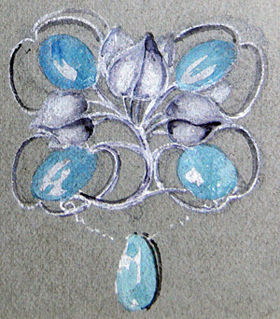 This Project was realised as an exhibition which took place at Compton Verney Art Gallery from the 27th June 2015 to 13th September 2015.
This Project was realised as an exhibition which took place at Compton Verney Art Gallery from the 27th June 2015 to 13th September 2015.
The archive of drawings held by Hart’s Silversmiths provides not only an extraordinary aesthetic experience but also a fascinating insight into the processes of patronage and production in the silversmith’s workshop both in the heyday of the Arts and Crafts Movement and today. Objects from this remarkable archive will form the core of an exhibition currently in planning with Compton Verney. They will be juxtaposed with some finished silver objects as well as supporting materials from key archives and collections.
Hart’s is the direct descendent of the Guild of Handicraft, set up by Charles Robert Ashbee in the East End of London in 1888 and moved to Chipping Campden in the Cotswolds in 1902, as part of the widespread trend in Socialist circles to find new ways of living in the countryside. Ashbee returned to London in 1908 when the Guild went bankrupt, but the Harts stayed on and the family still works today in the same studio, with the same tools, often using the same designs.
Ashbee is, after William Morris, the single most important figure in the Arts & Crafts movement. His influence was international and his works in silver, the drawings for many of which are in the archive, are in many major museums and collections. The rich archive of drawings, as well as other material, held by the Harts is, therefore, extremely valuable. They recently received a grant from the Heritage Lottery Fund to clean and conserve the archive; Michael Hatt provided assistance with this application. The mounting of the exhibition will help to publicise the archive and its new accessibility through the website of the Harts Silversmiths Trust, as well as offering a scholarly challenge to the history of craft and, specifically, of the Arts & Crafts movement.
This exhibition will explore the role of drawing in the workshop, bringing together the different kinds of drawing from preliminary sketches to finished presentation drawings. Placed alongside tools and the finished silver objects, the exhibition will show visitors how these drawings function as part of the process of designing and making in the workshop.
In showing this, the exhibition will also reveal much about the social history of craft: the significance of the archive’s location in the Cotswolds; the social thought that underpinned the workshop and its organisation; and the fact that this is a continuing craft tradition rather than just a long vanished historical moment. Indeed, most important of all is that the exhibition will connect past and present, allowing a consideration of what remains and what has been lost from a tradition in the face of shifting economic circumstances and audiences.
T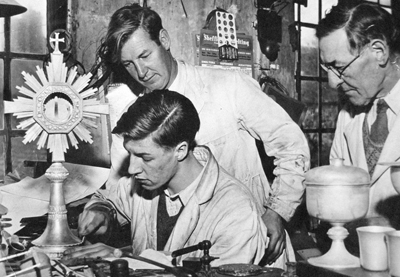 hree key theoretical concerns underpin the exhibition. The first of these is the matter of drawing as a practice, and the exhibition will exploit recent thinking about drawing as recently adumbrated in history of science. Research undertaken by scholars like Amy Meyers, Pamela Smith, and others has both emphasised drawing as a way of thinking rather than recording, and explored the ways in which artisanal knowledge is embodied - what Meyers and Smith have terms ‘ways of making and knowing’. Second is the question of authorship and artisanal production: everything produced by the Guild is routinely labelled as by C. R. Ashbee, whether in museums, in publications, or in the market. This myth of Ashbee as the author relies on a flawed understanding of the division of labour in the workshop, as well as an overly straightforward distinction between artist and artisan, or between designer and fabricator. The drawings will help to dismantle this myth, and so provide a proper consideration of drawing and the nature of making in workshop practice. The third is the relationship between the local and global: the Guild of Handicraft is an instance of the most intense local (Chipping Campden was very remote in 1902), and extraordinary global reach and influence. The standard generic approach in Arts & Crafts scholarship is inadequate here, and we need to start thinking, to coin an ugly neologism, about the ‘trans-local’, pinpointing more rigorously the nature of the connections between, for instance, the Cotswolds and Darmstadt or Chicago or elsewhere.
hree key theoretical concerns underpin the exhibition. The first of these is the matter of drawing as a practice, and the exhibition will exploit recent thinking about drawing as recently adumbrated in history of science. Research undertaken by scholars like Amy Meyers, Pamela Smith, and others has both emphasised drawing as a way of thinking rather than recording, and explored the ways in which artisanal knowledge is embodied - what Meyers and Smith have terms ‘ways of making and knowing’. Second is the question of authorship and artisanal production: everything produced by the Guild is routinely labelled as by C. R. Ashbee, whether in museums, in publications, or in the market. This myth of Ashbee as the author relies on a flawed understanding of the division of labour in the workshop, as well as an overly straightforward distinction between artist and artisan, or between designer and fabricator. The drawings will help to dismantle this myth, and so provide a proper consideration of drawing and the nature of making in workshop practice. The third is the relationship between the local and global: the Guild of Handicraft is an instance of the most intense local (Chipping Campden was very remote in 1902), and extraordinary global reach and influence. The standard generic approach in Arts & Crafts scholarship is inadequate here, and we need to start thinking, to coin an ugly neologism, about the ‘trans-local’, pinpointing more rigorously the nature of the connections between, for instance, the Cotswolds and Darmstadt or Chicago or elsewhere.
Exhibition organised by Compton Verney in collaboration with, and generously supported by, The University of Warwick and The Hart Silversmiths Trust. Exhibition research enabled with support from The Paul Mellon Centre for Studies in British Art and conservation with support from the Heritage Lottery Fund.

